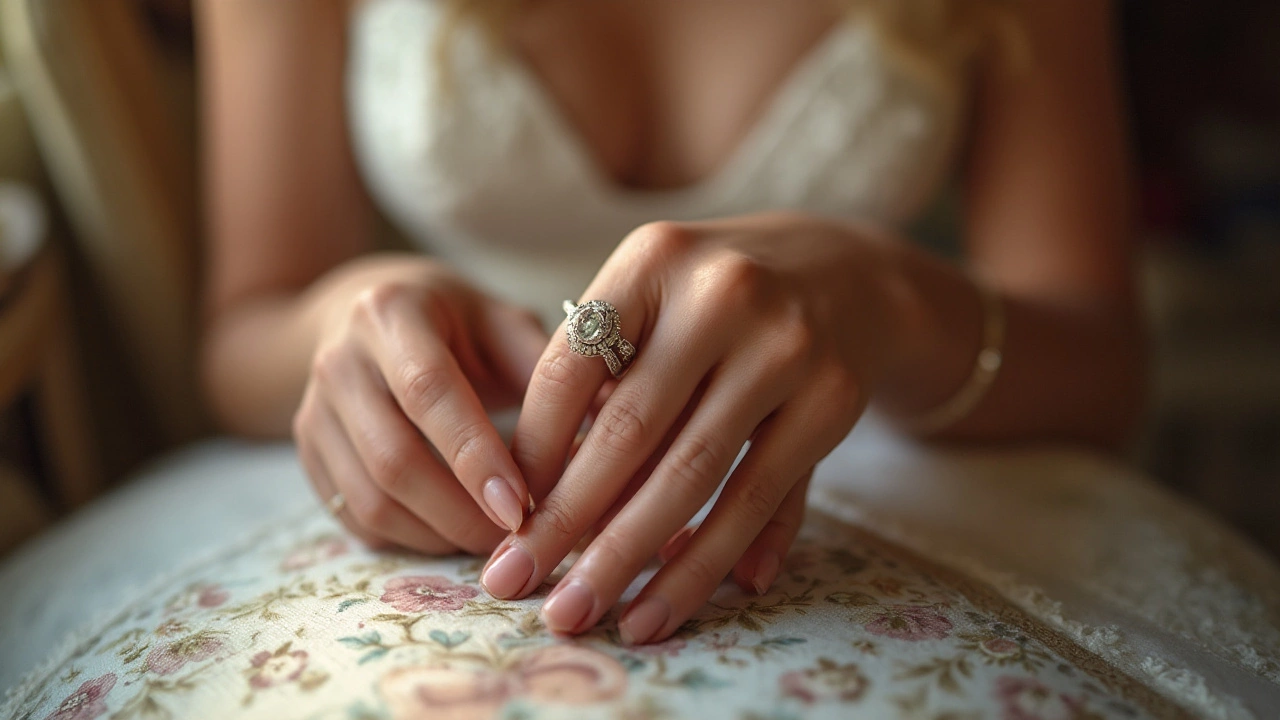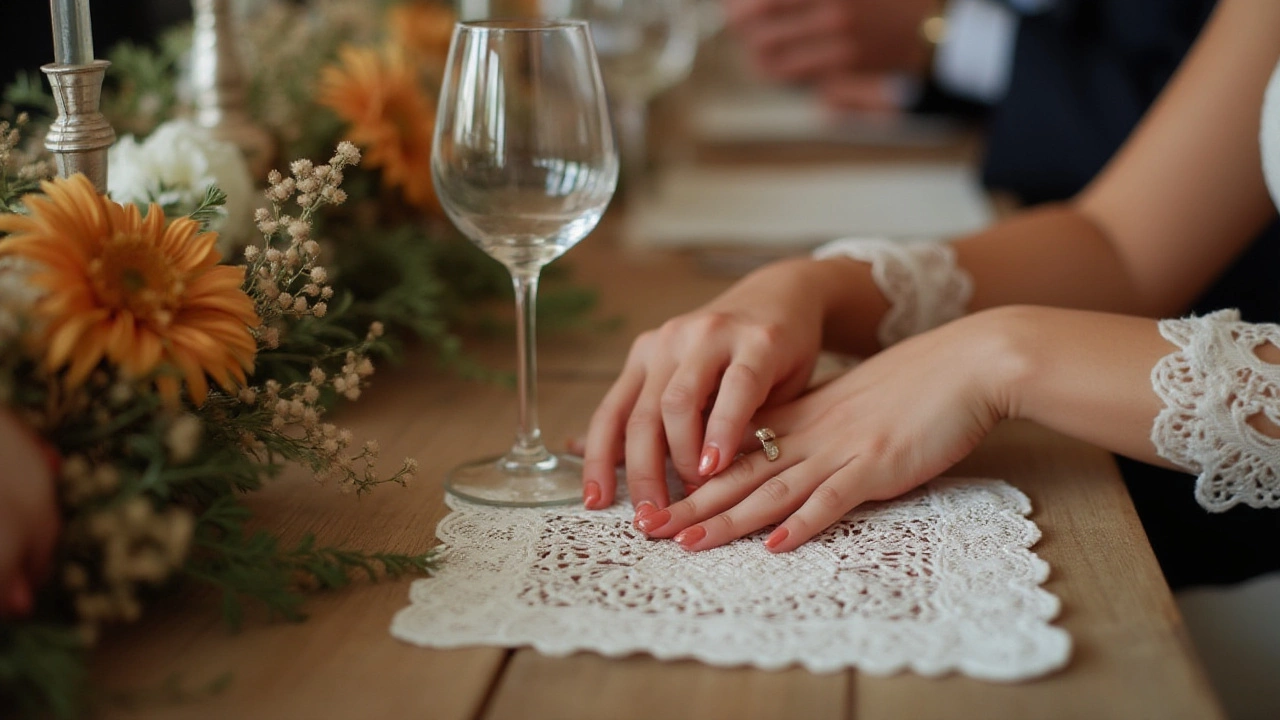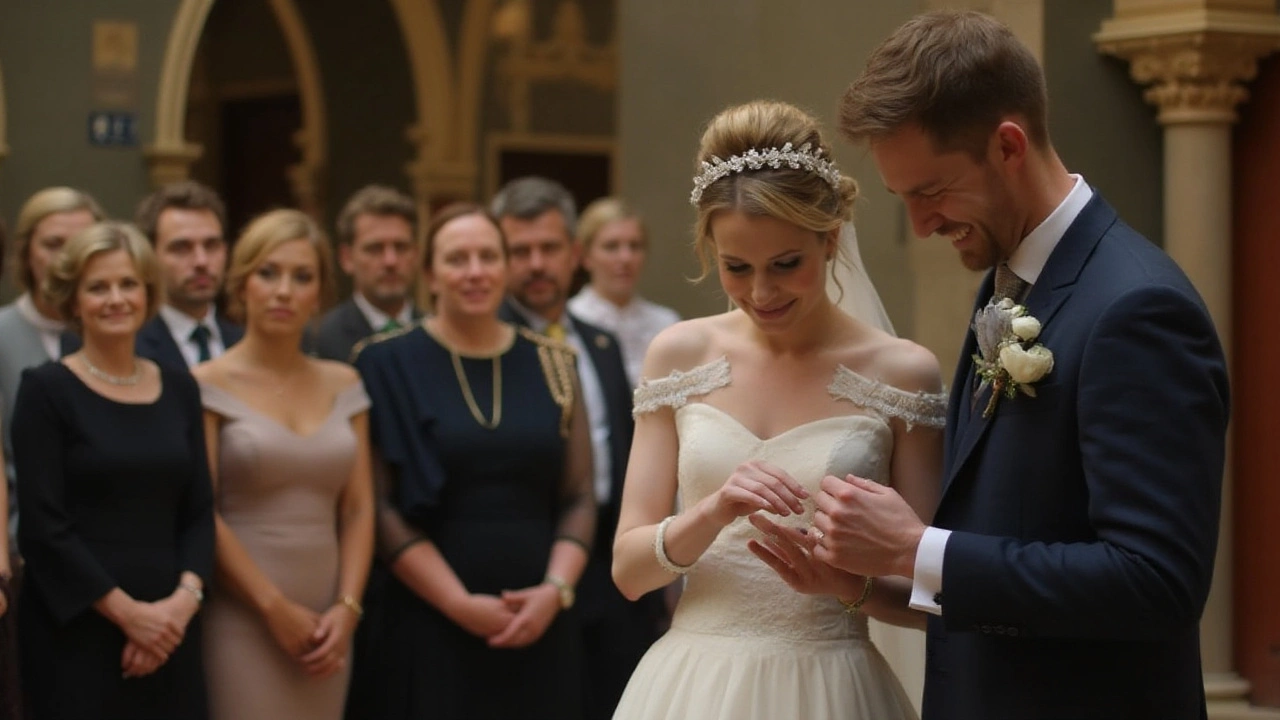Few moments in life are as exciting as a wedding day—the culmination of a romantic journey marked by symbolism and tradition. Yet, one curious question that often arises during the flurry of wedding preparations is why many choose to remove their engagement rings during the ceremony.
Historically, there are roots stretching back centuries that provide a backdrop to this practice, with various cultural nuances dictating the significance of each ring's role. Beyond tradition, some believe the wedding band, symbolically taking the 'stage' during the ceremony, should shine without distraction.
In today's world, personal preferences and modern trends sometimes overturn even the oldest customs. Couples may decide based on practicality or personal beliefs about what feels right in this important moment.
This article aims to demystify this charming ritual, offering tips on incorporating your engagement ring into the ceremony and perhaps inspiring a new tradition of your own.
- Historical Significance
- Symbolism of the Wedding Band
- Modern Trends and Preferences
- Tips for Your Wedding Day
- Personal Stories and Tips
Historical Significance
The practice of removing an engagement ring during the wedding ceremony may seem like a mere formality to some, but its roots dig deep into history. In many Western cultures, this custom is grounded in a rich tapestry of tradition dating back to ancient Rome. Romans placed great importance on the fourth finger of the left hand, believing it housed the 'vena amoris' or the vein of love, directly connecting to the heart. Thus, the ring was not just a decorative ornament but a symbol of a deep emotional and physical connection.
During the ceremony, the groom places the wedding band on the bride's ring finger, symbolizing the formal and public sealing of their union. As the wedding band is seen as the ultimate symbol of commitment, some traditions held the idea that the engagement ring should step aside for this new token to take center stage. In medieval Europe, engagement rings were often considered a sign of a contract, one that would be fulfilled with the exchange of wedding bands.
Interestingly, the first known use of a diamond engagement ring is traced back to 1477 when Archduke Maximilian of Austria presented one to Mary of Burgundy. Diamonds signified enduring strength and permanence, quite similar to the vows exchanged during matrimonial ceremonies.
"A diamond is forever," the iconic De Beers slogan, reflects a sentiment that can be traced through the ages, aligning itself with the symbolism of enduring marital union.
The custom might have practical origins too. Historically, the wedding band signified more than just love; it was a proof of transfer of wealth and titles, making it of utmost importance during the ceremony. By temporarily moving the wedding ring into the spotlight, it served as a visible pledge to everyone present of the new journey the couple was embarking on. The formality of showing the wedding band clearly to witnesses was paramount, underlining the legal and social commitment being made.
In today's increasingly globalized world, while some traditions shift and adapt, this practice brings a quaint and endearing connection to our ancestors' customs. Whether one adheres to these traditions or forgoes them in favor of personal choice, the story behind the engagement ring and the profound history it carries enriches the narrative of the wedding day itself.
Symbolism of the Wedding Band
Few symbolic gestures capture the essence of marriage quite like the exchange of wedding bands. These unbroken circles, made of precious metals, represent eternity, unity, and an unyielding commitment to one another. Throughout history, the act of placing a wedding band on each other's finger has stood as a testament to the enduring bond shared between partners. It is a ritual that predates society itself, tracing back to ancient times, including the Egyptians who believed that the ring finger contained a 'vein of love' leading directly to the heart.
The symbolism invested in the wedding ceremony is multi-faceted, transcending mere tradition. Each bride and groom takes part in a rite that speaks to a continuity of love from one generation to the next, a promise in the form of the simplest, yet most profound object. In many cultures, the wedding band carries the weight of legacy, familial ties, and societal expectations. One historic account tells us that in early Rome, wedding rings were made of iron, symbolizing strength and permanence, a profound expression of a couple's enduring relationship.
The choice of material for a wedding band today often carries its own special symbolism—gold for its purity and resistance to tarnish, platinum for its rarity and strength, or titanium for its modernity and resilience. Couples might seek stones or engravings that further personalize their union, adding layers of special meaning to their ring exchange. A wedding band, minimalist yet deeply profound, is more than a promise; it's a visible declaration that weaves the past, present, and future into a single, meaningful gesture.
As modern couples infuse their weddings with personal touches, wedding bands often encapsulate stories unique to the relationships they represent. Whether through an engraving that captures a shared sentiment or a design that reflects a couple's journey together, each detail contributes to the rich symbolism of the piece. A loved one's band may have a monogram or a date inscribed on the inside, symbolic memories etched into eternal time.
"A circle has no beginning or end, and is therefore a symbol of infinity. It is endless, eternal, just the way love should be," writes John Smith, a renowned jewelry historian. Such descriptions remind us why the wedding band remains an indelible symbol of love through changing times and trends.
When the notion of commitment has faced societal shifts and changes, the tradition of the wedding band has held steadfast. Yet, it adapts to modern sensibilities; some select distinct shapes or pair their engagement ring with a matching or contrasting band to express their style. What remains unchanged is the sentiment and the gravitas that the band holds within its form. Symbolism blends with personal relevance, allowing each couple’s story to shine as brightly as the band they select to symbolize it.

Modern Trends and Preferences
In the kaleidoscope of wedding traditions, modern trends often add a new twist to old customs, and the etiquette around wearing an engagement ring during the wedding ceremony is no exception. Today, the old dictates of tradition find themselves beautifully entwined with individual expressions and the desire to create unique, personal experiences. One popular trend among couples is the blending of vintage elegance with contemporary flair, allowing for a more personalized approach to wearing rings. Many now choose their preferences based on aesthetics, practicality, and what resonates with their sense of style.
Another captivating preference that has gained momentum is the mix-and-match approach to engagement and wedding rings. Brides are opting for unique pairings—whether it’s mixing metals or styles—that defy conventional matching rules. This freedom to experiment resonates with a generation that values personal expression over age-old norms. With the rising popularity of customization, many jewelers now offer design-your-own-ring services, encouraging couples to create a unified yet distinct look that carries deeper meaning.
Minimalistic designs have also seen a rise, reflecting a broader lifestyle trend of simplicity and mindfulness. The chic and understated allure of a slender band allows the stone to take center stage in the engagement ring, creating an elegant contrast with the more elaborate wedding band that follows. This aligns with a movement away from excess, celebrating the love rather than the jewelry's opulence. Moreover, a resurgent interest in the ethical sourcing of jewelry has prompted many couples to prioritize sustainability in their choice of rings.
For some, the decision is influenced by practical considerations. Brides engaged in active lifestyles, for instance, often opt to wear their engagement ring on a chain around their neck during the ceremony, ensuring their rings stay pristine and practical for daily wear post-wedding. Liam's cousin, an avid rock climber, amusingly shared how this choice allowed her to flaunt her love with both a symbolic commitment and a practical touch.
Beautifully and pragmatically embracing this change, wedding designer Kate Smith observes, "Today's couples are driven by meaning and originality, opting for what's comfortable and true to themselves rather than sticking rigidly to tradition." Her words echo a growing sentiment that prioritizes individual preference over societal expectation.
The blending of heritage and innovation in the realm of wedding jewelry symbolizes an era where choice defines ceremony. As couples explore the bounds of tradition and personal taste, new trends continue to emerge, each encapsulating the wearer's spirit and telling a story of love in a world that values authenticity. The key is to create a moment that feels right and genuine, marking a milestone that is uniquely theirs to treasure forever.
Tips for Your Wedding Day
Your wedding day is finally here, and amidst the excitement and anticipation, it's natural to ponder over the littlest details, like whether to wear or remove your engagement ring during the ceremony. For many, this decision encapsulates a blend of tradition, personal comfort, and style. Interestingly, this particular day offers a golden opportunity to showcase a seamless transition from fiancé to spouse, symbolized by the exchange of rings.
When deciding whether to keep your engagement ring on or take it off, consider the symbolism of the new beginning that the wedding band brings. To smoothly integrate your engagement ring into your ceremony, one popular method is to switch it to the right hand temporarily. This way, your wedding band is first placed on a fresh finger, symbolizing the start of a new chapter. Post vows, you can slip your engagement ring back onto the left hand, securely nestling the wedding band underneath. This little switch not only ensures clarity during the exchange but also respects tradition.
Some brides opt to forgo the engagement ring entirely during the ceremony, stashing it safely until the day's formalities conclude. This choice can reflect a nod toward simpler aesthetics or perhaps an aversion to any risk of losing or misplacing the beloved gem. "A wedding band shouldn't compete for attention," remarked renowned etiquette expert Emily Post, in a quote often shared in bridal circles. Her words resonate with those who believe the wedding band should stand alone in its initial moment of glory.
Moreover, practicality may dictate your ring choices based on the setting of your ceremony. Outdoor weddings or beachside vows might warrant leaving your engagement gem somewhere secure to avoid any unfortunate slips or losses. If your ring has a high setting, it could be prudent to remove it to prevent any snagging on delicate fabrics like lace. Alternatively, some brides select matching sets of engagement and wedding rings, a popular modern trend which hinges the decision on harmonious aesthetics.
For the couple that loves careful planning, your wedding photographers being aware of your choice regarding ring arrangements means they can capture those intimate moments perfectly. Also, remember to get your rings cleaned beforehand, ensuring they shine brilliantly in photographs. Gathering insights from recently married friends often proves beneficial, as their experiences can highlight tips you've never thought of.
Ultimately, the approach to your wedding day ring routine is deeply personal. Whether guided by tradition, ambiance, or aesthetic preference, make decisions that feel authentic to you both. Remember, the essence of the day lies not in the rings themselves but in the shared commitment and love they symbolize. Choose options that enhance the joy of your celebration, allowing your unique story to unfold just as dreamed.

Personal Stories and Tips
When it comes to one of the most important days of your life, personal stories hold a wealth of wisdom and context that generic advice may not cover. For instance, my dear friend Sarah shared a touching anecdote from her own wedding, which adds a layer of personal connection to the age-old tradition. On the day of her wedding, she decided to transfer her engagement ring from her left hand to her right. She wanted her new wedding band to be the 'star' during the ceremony, as hindsight would reveal it in photographs and memories. Sarah's decision was both a personal choice and a nod to tradition, which gave her peace knowing that she was aligning with a custom she'd admired.
Interestingly, not everyone might be aware that this practice is more than a matter of preference. It's not uncommon to hear tales of brides keeping their engagement ring on to symbolize the journey leading up to the marriage. I stumbled upon an article in Brides Magazine where they quoted a jeweler who said, "An engagement ring is a symbol of the promise that leads to the commitment of marriage. Leaving it on during the ceremony can mean you cherish the love story that brought you to this day." These narratives not only provide insight but also reflect diverse choices couples make based on their own values and cultural customs.
Now, let's explore some practical tips for successfully incorporating both your engagement ring and wedding band into your special day. First, comfort should be a priority, especially if you're not accustomed to wearing multiple rings. Attending a pre-wedding fitting with both rings can help you see how they feel paired together during the hustle and bustle of the day. If you opt to take off your engagement ring during the ceremony, designate a trusted person to keep it safe or wear it on a chain beneath your dress for added security and sentiment.
Amidst these stories and insights, cultural aspects can't be ignored. In some cultures, swapping rings between specific fingers signifies deeper meanings often tied to mythology or spiritual beliefs. For instance, in Germany and Austria, it is customary to wear the engagement ring on the left and the wedding ring on the right hand. A study indicates that cultural traditions strongly influence these decisions, allowing couples to embrace unique interpretations of love and commitment. To make your wedding day more personalized, consider incorporating historically significant rituals or creating new ones unique to your relationship.
All in all, when it comes to deciding whether to remove your engagement ring during the wedding ceremony, there is no right or wrong choice. Your wedding is an expression of your love story, and whichever path resonates with you will undoubtedly add richness to the experience. With these personal stories and tips in mind, you're in a better position to make an informed decision, reflective of your personality and the precious bond you're about to celebrate.

